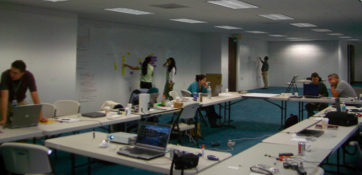Difference between revisions of "Advanced Design with Patterns, AI, & Agile Modeling"
(Created page with "== Overview == 4 days. probably 9:00-17:00 <br> <br> This popular, high-impact, and hands-on course on mastering advanced object-oriented design (OOD) and design patterns (pri...") |
|||
| (7 intermediate revisions by the same user not shown) | |||
| Line 3: | Line 3: | ||
<br> | <br> | ||
<br> | <br> | ||
| − | This popular, high-impact, and hands-on course on mastering advanced | + | This popular, high-impact, and hands-on social course is on mastering advanced software design (eg. in OO & functional designs) with (1) patterns, (2) AI, and (3) agile modeling, leveraging the (A) generative strengths of AIs plus the (B) visual and co-creative strengths of small teams of ''people'' modeling together in ''vast whiteboard spaces''. Wow! Super fun and useful, and includes an important social learning experience: the power of a small real team together at a vast whiteboard space (around their computers) that invites (1) creativity & communication, (2) learning & creating together, and (3) really ''seeing'' what you mean in shared code and design. |
<br> | <br> | ||
<br> | <br> | ||
| − | + | And of course, in this course you learn something newly important: How to work with AIs and people developing together, both technically and socially? How to guide an overarching good design or architecture, when delegating code for smaller parts to AIs? Or when delegating large parts? | |
<br> | <br> | ||
<br> | <br> | ||
| − | + | [[image:agile_modeling_2.jpg|500 px]] | |
| − | |||
| − | |||
| − | |||
| − | |||
| − | |||
| − | |||
| − | |||
| − | |||
| − | |||
| − | |||
| − | |||
| − | |||
| − | |||
| − | |||
| − | |||
| − | |||
| − | |||
| − | |||
| − | |||
| − | |||
| − | |||
| − | |||
| − | |||
| − | |||
| − | |||
| − | |||
| − | |||
| − | |||
| − | |||
| − | |||
| − | |||
| − | |||
| − | |||
| − | |||
| − | |||
| − | |||
| − | |||
| − | |||
| − | |||
| − | |||
| − | |||
| − | |||
| − | |||
| − | |||
| − | |||
| − | |||
| − | |||
| − | |||
| − | |||
| − | |||
| − | |||
| − | |||
| − | |||
| − | |||
| − | |||
| − | |||
| − | |||
| − | |||
| − | |||
| − | |||
| − | |||
| − | |||
Latest revision as of 14:14, 13 July 2023
Overview
4 days. probably 9:00-17:00
This popular, high-impact, and hands-on social course is on mastering advanced software design (eg. in OO & functional designs) with (1) patterns, (2) AI, and (3) agile modeling, leveraging the (A) generative strengths of AIs plus the (B) visual and co-creative strengths of small teams of people modeling together in vast whiteboard spaces. Wow! Super fun and useful, and includes an important social learning experience: the power of a small real team together at a vast whiteboard space (around their computers) that invites (1) creativity & communication, (2) learning & creating together, and (3) really seeing what you mean in shared code and design.
And of course, in this course you learn something newly important: How to work with AIs and people developing together, both technically and socially? How to guide an overarching good design or architecture, when delegating code for smaller parts to AIs? Or when delegating large parts?
